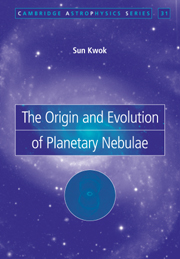Book contents
- Frontmatter
- Contents
- Preface
- 1 History and overview
- 2 Ionization structure of planetary nebulae
- 3 Nebular line radiation
- 4 Nebular continuum radiation
- 5 The neutral gas component
- 6 The dust component
- 7 Observations of the central star of planetary nebulae
- 8 Morphologies of planetary nebulae
- 9 Problems and questions
- 10 Asymptotic giant branch stars – progenitors of planetary nebulae
- 11 Evolution of the central stars
- 12 Formation of planetary nebulae
- 13 Dynamical evolution of planetary nebulae
- 14 Protoplanetary nebulae – the transition objects
- 15 Evolution to the white dwarf stage
- 16 Distances to planetary nebulae
- 17 Comparison between evolutionary models and observations
- 18 PN in the galactic context
- 19 Chemical abundances
- 20 Planetary nebulae in other galaxies
- 21 Concluding remarks
- References
- Appendix List of symbols and abbreviations
- Subject index
6 - The dust component
Published online by Cambridge University Press: 04 November 2009
- Frontmatter
- Contents
- Preface
- 1 History and overview
- 2 Ionization structure of planetary nebulae
- 3 Nebular line radiation
- 4 Nebular continuum radiation
- 5 The neutral gas component
- 6 The dust component
- 7 Observations of the central star of planetary nebulae
- 8 Morphologies of planetary nebulae
- 9 Problems and questions
- 10 Asymptotic giant branch stars – progenitors of planetary nebulae
- 11 Evolution of the central stars
- 12 Formation of planetary nebulae
- 13 Dynamical evolution of planetary nebulae
- 14 Protoplanetary nebulae – the transition objects
- 15 Evolution to the white dwarf stage
- 16 Distances to planetary nebulae
- 17 Comparison between evolutionary models and observations
- 18 PN in the galactic context
- 19 Chemical abundances
- 20 Planetary nebulae in other galaxies
- 21 Concluding remarks
- References
- Appendix List of symbols and abbreviations
- Subject index
Summary
The infrared spectrum of PN was expected to be dominated by forbidden-line emissions from the ionized gas, and the discovery of strong infrared excess in NGC 7027 was totally unpredicted (Gillett et al, 1967). A photometric survey by Cohen and Barlow (1974, 1980) using the 1.5-m telescope at Mt. Lemmon showed that many PN display strong infrared emission from dust. Far infrared photometry observations from the Kuiper Airborne Observatory (KAO) by Telesco and Harper (1977) found the dust in NGC 7027 to be cool, with a color temperature of ∽100 K. Further KAO observations by Moseley (1980) confirmed the presence of cool dust in 13 PN.
The discovery of cool dust in PN and the observations of circumstellar dust envelopes in AGB stars (Section 10.4.1) suggest that they share the same origin (Kwok, 1982). If PN descend from mass-losing AGB stars, then the remnants of the AGB dust envelope must still be present in PN. The dispersal of the dust envelope since the end of the AGB implies a gradual decrease of the dust temperature, and the shifting of the peak of the dust continuum from mid-infrared to the far-infrared. According to the Wien's law, a blackbody of 100 K will peak at 30μm, beyond the longest infrared window observable from the ground. Since the flux decreases exponentially on the short wavelength side of the Planck function, dust emission from PN is difficult to detect from the ground.
- Type
- Chapter
- Information
- The Origin and Evolution of Planetary Nebulae , pp. 67 - 74Publisher: Cambridge University PressPrint publication year: 2000

